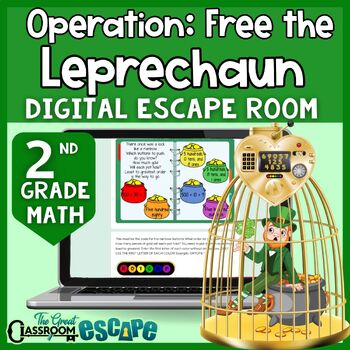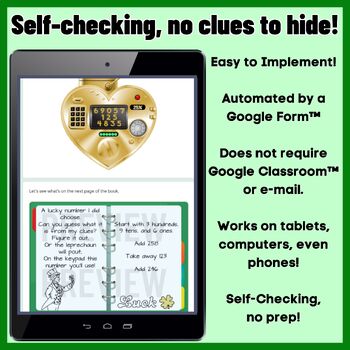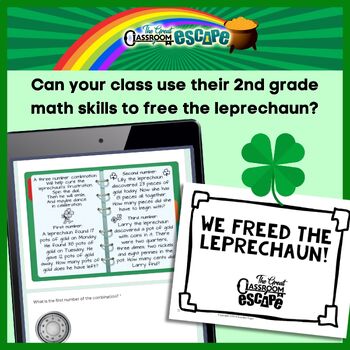2nd Grade Math St. Patrick's Day Digital Escape Room Activity Fun Center or Game
- PDF
- Google Apps™
- Easel Activity

What educators are saying
Also included in
- These 2nd grade math digital escape rooms are fun and engaging and cover a wide variety of second grade math standards. It can be hard to keep kids focused before a holiday, but these escape rooms are sure to keep students engaged in standards based learning before vacations and school holidays. ThePrice $21.98Original Price $27.72Save $5.74
Description
Can your second grade math students use their math skills to free the leprechaun in this St. Patrick's Day math activity? They'll race to stop word problems involving addition and subtraction within 100; compare the value of numbers under 1,000; read numbers using expanded form and place value notation; find the value of a set of coins; compare the value of numbers; and much more! This exciting 2nd grade math St. Patrick's Day digital escape room can be completed by anyone with an internet connection and a device. Students follow the clues in a Google Form™ to unlock the leprechaun trap and set the lucky leprechaun free. Best of all, the whole breakout process is automated by the online Google Form™! There are no clues to hide or answers to check, making this activity easy for teachers to implement!
Clues written in limericks make this St. Patrick's Day themed math activity even more fun for your second graders. An optional cross-curricular limerick writing activity is also included.
Students will need to have internet access and a device to access the Google Form. The activity works on laptops, tablets, or even phones! A QR code is provided for students to scan, or a URL can be clicked on.
Here's what you will find in the PDF:
- Quickstart guide and detailed instructions
- A note from a leprechaun asking for help with a QR code to access the Google Form.
- Printable helper page for students to work out the puzzles on
- Printable versions of the clues for students who work better on paper instead of on the computer
- Answer key and teacher tips
- Optional success signs to snap a photo with when students finish the breakout
- Fun St. Paddy's Day themed photobooth items
- Optional instructions for a limerick writing activity
- Tools and tips for distance learning implementation
In order to complete this activity, students need to be able to:
- Understand that the three digits of a three-digit number represent amounts of hundreds, tens, and ones (CCSS.2.NBT.A.1)
- Read numbers to 1000 using base-ten numerals, number names, and expanded form. (CCSS.2.NBT.A.3)
- Compare the values of three digit numbers (CCSS.2.NBT.A.4)
- Add and subtract within 1,000 (no regrouping is required for the subtraction) (CCSS.2.NBT.B.7)
- Use addition and subtraction within 100 to solve one- and two-step word problems (CCSS.2.OA.A.1)
- Calculate the value of a set of quarters, dimes, nickels, and pennies (CCSS.2.MDC.8)
- Solve simple substitution ciphers
Digital escape rooms are a great way to review material, encourage collaboration, integrate technology, and keep students engaged with a fun, educational activity related to a holiday!
FAQ
- Do students need to have Gmail™ accounts? NO! Anyone with internet access and a tablet, computer, or even phone can complete the breakout.
- How long will this take? That is the hardest question as the answer varies depending on each classroom, student, or group. Some students with a firm grasp on the concepts covered in this escape room will be able to complete the challenge quickly (30 minutes), but most will take longer. The majority of students will take between 35-55 minutes. The form will not save student data, so if you are worried about your students not finishing on time, simply have them write their answers on scratch paper. They can then come back and quickly re-enter their answers and pick up where they left off.
- Will students have to search the web to figure out the puzzles? NO! All of the information needed will be provided in the Google Form™. The math in this activity is all standards-based.
- Can this be used for distance learning? Absolutely! The last three pages of the pdf include detailed directions and tips to help you successfully implement this activity for remote learning.
Check out all of The Great Classroom Escape's Digital Math Breakouts!







